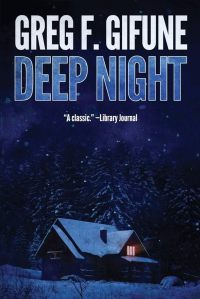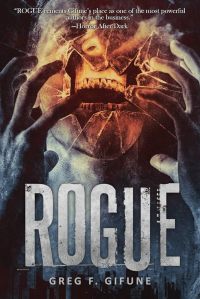Orphans of Wonderland
Greg F. Gifune
JournalStone Publishing (July 27, 2018)
Reviewed by Andrew Byers
Originally published in 2015 by Samhain Publishing, Orphans of Wonderland was re-released by JournalStone in 2018. The protagonist of Orphans of Wonderland is Joel Walker, a journalist haunted by a dark history. Twenty years prior, he delved into the investigation of a ritual killing, a tale that captivated the masses during the Satanic hysteria of the 1980s. Walker’s pursuit of truth left him shattered, a victim of a nervous breakdown, forcing him into a reclusive, small-town existence. Joel’s life shifts when he receives word that one of his closest friends growing up has been murdered savagely and inexplicably. Reluctantly, as a favor to his friend’s daughter, Joal returns to his hometown and begins investigating. This forces Joel to confront the shadows of his past. It soon becomes clear that Joel’s friend was killed because of a set of unresolved and unexplained circumstances from their childhood. Was Joel’s friend really being haunted by dark, inhuman figures? What really happened to Joel and his friends when they were children? Has the past really come back to haunt them?
In Orphans of Wonderland, the past becomes an inescapable labyrinth, its secrets lurking beneath the surface, waiting to ensnare those who dare to revisit it. Gifune, a maestro of psychological horror, weaves a narrative that transcends the conventional boundaries of the genre, offering readers a haunting exploration of paranoia, madness, and the insidious nature of evil.
The characterization in Orphans of Wonderland is a testament to Gifune’s ability to craft nuanced, multi-dimensional characters. Joel Walker, a man tormented by the ghosts of his past, is a compelling protagonist. His internal struggles, shaped by the trauma of his earlier investigation and whatever happened to him as a child, add layers of complexity to his character. Gifune’s portrayal of Walker’s descent into the murkiness of his own memories is both haunting and evocative.
The atmosphere in Gifune’s novel is a palpable force—an oppressive darkness that pervades every page. Joel is surrounded by people who are either clueless, and thus either unhelpful or in danger themselves, or are actively inimical but holding the answers to the questions that Joel is asking. The backdrop of urban decay, laden with the weight of buried secrets, becomes a character in its own right, its quiet streets concealing horrors that refuse to remain dormant.
Pacing, a critical element in psychological horror, is meticulously calibrated in Orphans of Wonderland. Gifune manipulates the rhythm of the narrative, alternating between introspective moments of dread and explosive revelations. The gradual unfolding of the mystery creates an unsettling tension, holding readers captive until the final revelation.
As the narrative hurtles toward its climax, Gifune skillfully explores the interplay between paranoia, madness, and the nature of evil. Orphans of Wonderland becomes a harrowing exploration of the thin line that separates the rational from the irrational, the real from the imagined. The novel’s denouement is both chilling and satisfying, leaving lingering questions that resonate beyond the final page. While Gifune seems to write only stand-alone novels (as far as I know), I’d actually love to see him revisit this setting and characters. There’s more to be explored here, and, I think, connected up with some of his other novels, including God Machine.
Gifune has many strengths as a writer, but having read much of Gifune’s oeuvre, I want to highlight three that are common throughout his fiction that come together to shine in Orphans of Wonderland. First, Gifune writes groups of old friends very well. While it is easy for a writer to say that a group of characters grew up together and have known each other for decades, that’s very hard to pull off convincingly. Gifune does so with aplomb. Second, he is a master of describing gritty, hyper-realistic, almost noir-ish settings and lives—stories and settings that feel very real—and then injecting elements of supernatural horror in a way that does not unbalance or upset the very real places and people he is writing about. This is harder to do than it seems. Think about the classic horror movie that is ruined the first time that the camera pans over and the monster is revealed to the viewer. And third, Gifune writes a certain type of unreliable narrator extremely well. This can be done cheaply and to ill effect easily, but Gifune takes care to craft protagonists who learn about themselves, the world around them, and their own pasts at the time as the reader. Gifune doesn’t tell his stories via tricksters or liars, he lets his stories unfurl by having his protagonists conduct genuine investigations into their worlds, and when they learn that reality is not what they had imagined, they are as shocked and horrified as we are. We see strong evidence of all three strengths here in Orphans of Wonderland.
Greg F. Gifune’s Orphans of Wonderland transcends the trappings of conventional horror, offering readers a cerebral and atmospheric exploration of the darkness that resides within and without. This is not a tale of gratuitous scares but a haunting journey into the recesses of the human psyche and the evil than some do for power. For those seeking a psychologically rich and thought-provoking horror experience, Orphans of Wonderland offers a descent into the depths of the past that will linger in the reader’s mind long after the shadows dissipate. Definitely recommended.
This review originally appeared in Hellnotes.






